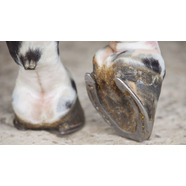What is Hoof Thrush and How Do I Treat It?
Author: Alicia Date Posted:24 June 2024

Don't worry we've got you covered! We have put together some simple ways to treat your horses thrush and to prevent it before it happens again!
What is Thrush?
-
Thrush is an infection that causes the destruction of the frog in your horses hoof. This destruction is caused by an anaerobic bacteria and fungi that is not contagious. It causes a thick black, distinct foul-smelling discharge. The infection usually occurs in the grooves on either side of the frog (collateral sulci) and/or the central sulcus (in the middle of the frog). There are several bacteria and fungi thought to be involved in thrush. Thrush is one of the most common conditions of the hoof as it is the breeding ground for bacteria.
- Thrush usually occurs when there is an excess of moisture in your horses feet (standing in mud, or wet conditions in the paddock).
- You can spot thrush by its signature stinky odor and oily ooze when picking out your horse’s hoof. Your horse may also be showing signs of lameness (pain or sensitivity to the hoof or leg).
- Understanding and treating your horses feet is essential in ensuring thrush does not become a chronic issue in your horse. If left untreated, it may penetrate the sensitive structures of the hoof and cause temporary to permanent lameness.
Common causes of Thrush in your horses feet:
If your horse experiences recurring thrush in one or more hooves, it's essential to seek the expertise of a veterinarian, farrier, or hoof health professional. Collaborate with them to identify the root cause of the thrush in your horse's hoof and develop a corrective plan. Achieving a healthy, well-shaped, and balanced hoof may take up to a year, but the effort will pay off with no more thrush and no more daily medicating!
- Abnormal hoof shape – deep, narrow grooves (sulci) on either side of the frog are built-in traps for dirt and moisture and do not have much exposure to air—conditions thrush-causing microorganisms thrive in.
- Chronic lameness
- Poor circulation in the foot
- Improper trimming or hoof care
- Insufficient excercise or too much stall time
- Poor diet
So, how do I treat it? Here are some ways:
Please consol a vetinarian and/or farrier in the treatment of thrush in your horses feet*
- Have your vet or farrier cut away any dead tissue surrounding the infected site of the hoof.
- Gently scrub the hoof daily with an iodine scrub/ solution until the infection is gone. This will eliminate any microorganisms and help dry out the hoof. The bacteria responsible for the infection thrive in low-air environments, so exposing them to air is beneficial. Use an old toothbrush to thoroughly clean the groove
- Iodine solution can then be painted onto the hoof.
- We also have a wide range of treatments availble in the treatment of thrush! Read below!
- If the infection and damage is severe your vet may prescribe antibiotics and bandaging.
Prevention starts here:
-
It starts with hoof care! You want to ensure your horse is receiving regular and professional hoof care. This also means ensuring your horses hooves are well balanced and well-supported.
- Allow your horse to have daily excercise. Now, I know that many horses are in different paddock conditions. But, even allowing your horse a walk around outside of the dirty paddock will do wonders for your horses feet and wellbeing. Stall bound horses are more prone to developing thrush due to the lack of movement and stimulation to the hoof.
- Ensure your horse is kept in a clean, dry environment. Make sure there are no wet spots in their stall and/or they have somewhere in their paddock that is dry to stand in.
- Regularly clean out your horses feet. This will allow airflow into the infectious areas and dry out the hoof.
Our Top products in the treatment and prevention of thrush:
- Copper Sulphate
- Iodine Solution
- NAS Foot Rot 375mL
- Absorbine Hooflex Frog and Sole Care - 355ml
- David Hoof Aid 500ml
- Cordura Poultice Boot
- Poultices
Shop our whole range of Hoof Healthcare; HERE









